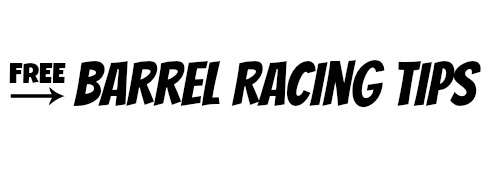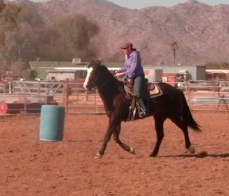Trotting on the wrong diagonal is like loping on the wrong lead.
What is a diagonal? When a horse trots, it has a 2 beat, diagonal gait. As the right front moves forward, the left hind (diagonally across) moves forward at the same time. As the left front moves, the right hind moves forward. When posting a trot there is a “correct” diagonal to post (spring up) on.
This practice is taken most seriously in the English discipline of riding and often overlooked in the Western discipline.
It is however just as important in Western riding if you believe in balanced conditioning and strong, engaged turns. As barrel racers, this is important. I have watched many NFR level and even World Champion barrel racers trot around on the incorrect diagonal so I’m not saying this is going to hold you back from your dreams. However, if you are like me, once you catch onto it you will realize how important it is and how it can give you the edge on your training and conditioning program. It will increase your horsemanship and feel with your horses.
It was my English riding background (might be more appropriate to call it a brief stint in 4-H) that brought “posting on the correct diagonal” to my attention. I have never had this taught or had it brought to my attention at any barrel racing clinic. I’m guilty myself of not bringing this to the attention of my own clinic students so I understand why a clinician might not “go there” in a 2 day workshop. However – it is important. Make an effort to learn this and your horses will thank you for your increased horsemanship.
To check and see if you are on the correct diagonal it is easiest to watch the front legs and use this phrase “rise and fall with the outside wall”. This means you should rise out of the saddle with the front outside leg (which will also have you rising with the opposite inside hind leg). Here is a video to demonstrate posting on the correct diagonal:
If you do a posting trot in a circle, you can actually ask your horses hind end to engage or drift out of the circle just by trotting on the correct or incorrect diagonal. In a circle at a trot the horses inside leg is actually taking a shorter step that the outside leg. If you are posting (going up off your seat) with the outside hind/inside front you will be going against the grain and actually asking your horse to make his inside stride as long as his outside stride (which will push his hip out/disengage him from the circle). You can easily help your trotting circles to be more controlled, collected and strong my posting on the correct diagonal. Try walking a small circle on foot yourself and you’ll recognize the shorter stride on the inside, longer step on the outside. The inside leg bears for weight as well, so by posting and rising with that inside hind (outside front) in a circle you are helping to take weight off that leg as it comes forward (which is already bearing more because you are in a circle).
If you long trot your horse in a straight line (and post) for conditioning reasons you will also want to know your diagonals. Trotting 5 miles on the same diagonal is like loping 5 miles on the same lead. You are only conditioning one side of the body at a time. The diagonal you rise and fall on will be a bit more work for the horse as their momentum sends you up out of the saddle. We want our horses to be balanced so you’ll want to “sit sit” halfway through your trotting workout to switch yourself to the opposite diagonal. I usually change at about 1/2 mile increments.
Another thing you can use this diagonal business for is checking soundness. If you post in a straight line on one diagonal and find the rhythm, then switch to the opposite diagonal you can feel for any changes in stride. If it feels different at a trot one diagonal to another there is a soundness/balance issue with your horse that needs to be addresses. Your horse should have the same bounce/push off to him once side to the other.
To start off with most people will have to look down to see if they are on the correct diagonal (just like people starting out have to look down to see if they are on the correct lead). Ideally you want to be able to improve your “feel” you can pick up the correct diagonal with your first posting rise out of the saddle. At very least be able to sit a stride and pick up the correct one right after you felt you were on the wrong lead.
It takes practice and it won’t come right away, but posting on the correct diagonal is an easy way to get on the same stride as your horse. Its worth the effort and your horse will thank you.
I welcome your feedback in the comments below. If you have questions about posting on the correct diagonal for barrel racing, please ask. If you have a question someone else likely does too. I would like to help improve your understanding of this horsemanship technique.


Comments 14
Thank You for the awareness of what diagonal I’m posting. It all make sense.
Author
You are welcome Kristi, glad you enjoyed the article.
Thank you. I always wondered how you posted and just never got. Been an Western pleasure, and barrel racer. Now in my older years went back to pleasure. (Back surgery, and 2 bad knees).
Author
You are welcome! Posting will help save your back too (no matter the discipline) and posting on the correct diagonal will really be of benefit. It helps really helps to “get in the groove” with your horses stride. Good for you for sticking it out in the saddle 🙂
This is really good! As a young rider I was taught this when I first learned to ride a few years ago, and a good drill to practise your posting is to do serpentines because then you have to change at every turn.
Author
Good idea! I have the serpentine drill on the http://www.barrelracingdrills.com site, but you’ve given me an idea for “part 2” of this article now 🙂
i still dont really understand how you know your on the correct diagnol and which one do you start on first? i mean which diagnol is correct to start with? ive heard you have to use your leg on the opposite side you want to start your lead/diagnol but dont understand how that would help? im new to leads and diagnols and stuff. racking/gaited horses are more my cup of tea but im interested in learning on my quarterhorse!
Author
Hi Shelby, the diagonal is a bit different than a lead in that you can change your diagonal without breaking down the speed of the horse (if you are loping on the wrong lead you’d have to break to a trot and change to the other) When trotting you can stay in a trot and “sit” “sit” two bounces/on stride in the saddle and you will be on the opposite diagonal. You can start on any diagonal and change if you need to but idealy you would start on the correct one (which would be rising out of the saddle at the same time as the outside leg of the horse steps forward). Have a look at the video again and watch how the rider moves with the outside leg. To take a lead at a lope you would use your outside leg, but at a trot you just ask for forward motion equally with your legs.
Author
You’ll want to try and start with the correct one (which is when you are going up at the same time the horses outside leg is going up). You might have to have someone call it our from the ground for you so you can see what the leg should look like as it comes forward as you go up. If you are on the wrong diagonal just sit a stride and bounce, bounce then up with the next one. Your leg on the outside for a lead really only applies to loping/cantering.
Pingback: Serpentine for Proper Preparation
This is great. Just what I needed to show my brother-in-law. I was taught this when I was younger and have always ridden this way (I’ve only ever ridden western). But when I first started riding with my brother-in-laws daughter I taught her this and he questioned what she was doing. He’d never seen it before and he’s an ‘experienced’ rider.
wow, now it makes sense. after 40 years of owning and riding my horse. I could never understand the people telling/yelling at me. YOU did it. thank you.
Good information. But as you stated in the beginning of your article …you learn posting with English riding ..& thats where posting belongs ..in English riding. Posting is not a western riding movement. I’m from the old school of ranch riding where you stand in your stirrups at an extended trot to cover miles of pasture riding. If you posted all day at this pace you would wear yourself out & wear your horses back out too ….up & down…up & down all day long. IT just don’t make sense . Plus you desensitize the horse with all the upper body movement of posting …up& down…up& down!!! You sit deep & quiet in the western saddle at a slow trot. ..which is also required in the western show pen. In my opinion posting just looks ridiculous for a western rider….
Author
This is a barrel racing tips site and I disagree that posting looks ridiculous for a western rider. It is also very good for sensitizing a horse to moving up in the saddle with energy to move out quick and then to sit down ( sitting jog for a turn) for a shorter stride. Posting done right is sitting light like you would on an egg shell, not hammering down like you imply. I agree that you are from the old school of ranch riding like you state. I have written this for barrel racers that wish to keep their horses hips engaged at the trot in circles, not riding the range.